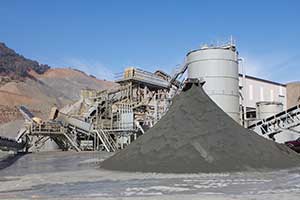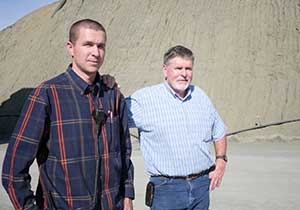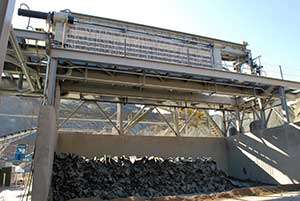How a California quarry settled its pond problems

Stevens Creek Quarry found a solution that eliminates the downtime from having to shut down the operation to deal with the settling pond.
A California quarry gets its settling pond problems settled once and for all.
For decades, workers at Stevens Creek Quarry in Cupertino, Calif., dreaded the monthly need to drain and clean out the quarry’s settling pond for its excess slurry tailings. Every 30 to 45 days, the entire operation had to shut down for up to eight days while the pond was cleaned, costing up to $80,000 each time.
Owner Rich Voss and his son, Operations Manager Jason Voss, were frustrated by the lost time, high costs and mounting inconveniences associated with the settling pond. Natural raw materials never consolidated in the pond, so flocculent had to be mixed into the tailings to allow settling, making disposal possible at the reclamation site.
Once the tailings accumulated in the pond, the plant had to be shut down for the pond to be cleaned out and made operational again. Additionally, the 170-acre operation had limited space for creating a second settling pond that would allow work to continue uninterrupted.
“It was such a problem being down for seven or eight days while the pond was being maintained,” Jason Voss says. “That, and the costs of it, made it a real issue for us. It was an issue that wasn’t going away if we didn’t find a solution.”
Fines recovery
Rich Voss called Scott O’Brien, director of process engineering for McLanahan Corp., and Ron DeDiemar, an industry consultant. O’Brien and DeDiemar took samples to be analyzed for potential options to de-water the fines from the effluent and help Stevens Creek eliminate the need for a settling pond altogether.
After analyzing size gradations in the materials to determine the amount of easily recoverable sand, an Ultra Fines Recovery System was recommended to reduce the fines currently going to the effluent treatment solution.
O’Brien said settling tests were run to determine the settling and compaction rates (as well as underflow densities) for deep cone and/or high-rate thickeners that would remove the remaining solids in the effluent.
The McLanahan team ran filtration tests on the resulting thickener densities to find the optimal equipment combination to minimize capital costs and produce cakes that could be easily handled and used for reclamation. Rich and Jason Voss selected a deep cone thickener over a traditional high-rate thickener as the higher-density underflow from the Deep Cone Thickener resulted in shorter press cycles, as well as a lower total capital cost.
Today, where the 100 x 200-ft. (30.5 x 60.9m) settling pond once existed, Stevens Creek now has a convenient area for stockpiling aggregate. DeDiemar says the quarry has been able to increase its stockpile/inventory area owing to the system, which will allow the operation to expand its volume if needed.
“We’ve eliminated the downtime from having to shut down the operation to deal with the settling pond,” Jason Voss says. “Even though the filtering is done as batches, it’s going while the aggregate plant is running. That makes it so much easier, and it saves us time and money.”

Steven Creek Quarry’s state-of-the-art processing allows it to custom blend materials for customers.
How it works
The Ultra Fines Recovery System has made it cost-effective to recover nominal -50 mesh x +400 mesh (38 micron) fines as a conveyable, stackable fine sand product. It recovers more than 20 tph of the fine sand. There are 2,200 gallons per minute of nominal -400 mesh effluent pumped into a surge prep tank for transfer to the deep cone thickener, which settles the solids into an underflow density of 45- to 55-percent solids before feeding it to the press.
The solids underflow feeds into the surge prep tank via gravity without the use of a pump, taking advantage of the head pressure generated in the deep cone thickener. The solids underflow from the thickener is then fed to the filter press and dewatered into cake that is 75 to 80 percent solids. The press recovers roughly 30 dry tph of filter cake, which is used for reclamation of the quarry.
The fine sand is mixed with soil and has been sold for use in soil remediation. The recycled water is available immediately for reuse in the wash plant, and thanks to Rich Voss’s creativity, the filter cake is also sold as washed levy fill.
Before Stevens Creek utilized the filter press, only one employee was needed to operate the entire plant. One of Voss’s main criteria was to be able to keep the wash plant operation a one-person job, which was accomplished because of the ease of use of the press.
“This equipment is field proven and offers the finest size fraction recovery available without the use of chemicals,” O’Brien says. “The modular construction helped keep installation costs low, and the design made start-up faster. No chemicals or polymers are needed, and the cyclones stay clog-free. They’re also large and less prone to plugging while recovering.”
Off-road racing
As a result of the new system, the quarry has realized savings of nearly $1 million a year in costs associated with not having a settling pond to drain. In addition, they no longer have 50 to 75 days each year where the entire operation is shut down.
This gives Rich and Jason Voss more free time to focus on their other passion outside the quarry.
During their time off, the two are the main partners in Voss Motorsports, an off-road racing team that has been gaining traction in the Best in the Desert Racing Association. Jason Voss is behind the wheel as the driver and has multiple victories in his career. He and Rich say there are similarities between working as a motorsports team and working with a crew like McLanahan to tackle an issue like the quarry’s settling pond.

Operations Manager Jason Voss (left) stands with his father, Rich Voss, owner of Stevens Creek Quarry.
“Whatever we set out to do, whether it’s here at the quarry or out racing in the desert with our team, there’s a team aspect to it,” Jason Voss says. “If you have a good support team and good machinery, you’re going to be successful.”
With the success of the Ultra Fines Recovery System and closed-loop water management systems, Stevens Creek is poised for the future – both in quarrying new aggregate and expanding its recycling efforts, which Rich Voss sees as the future. “Now that we have a reliable and efficient way to recover the mesh without the settling pond, we’re well-positioned for the future,” he says.
Stevens Creek Quarry
Stevens Creek Quarry Inc. was founded in 1939 and has served the Mid-Peninsula and South Bay regions of the San Francisco Bay area in producing, transporting and placing construction aggregates and engineered fill.
In addition, the company’s state-of-the-art processing increases production and allows it to custom blend materials for construction customers. Stevens Creek recycles asphalt and concrete, and processes clean fill, which offers additional savings to customers with projects in the vicinity of its locations.
The company operates out of five plant locations: Cupertino, Sunol, San Juan Bautista, San Jose and Sunnyvale. Other services available include trucking, street sweeping, private and public construction, and equipment rentals.
Take note
As a result of the new system, the quarry has realized savings of nearly $1 million a year in costs associated with not having a settling pond to drain.
Andrea Ritchey is marketing communications specialist for McLanahan Corp.
Photos: Stevens Creek Quarry











